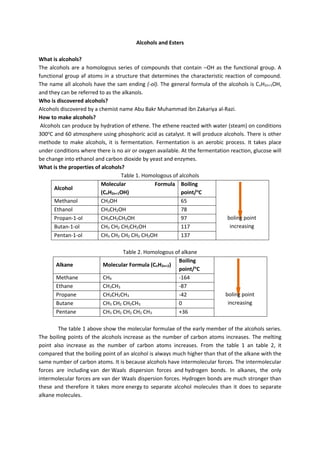
Alcohols and esters (background)
- 1. Alcohols and Esters What is alcohols? The alcohols are a homologous series of compounds that contain –OH as the functional group. A functional group af atoms in a structure that determines the characteristic reaction of compound. The name all alcohols have the sam ending (-ol). The general formula of the alcohols is CnH2n+1OH, and they can be referred to as the alkanols. Who is discovered alcohols? Alcohols discovered by a chemist name Abu Bakr Muhammad ibn Zakariya al-Razi. How to make alcohols? Alcohols can produce by hydration of ethene. The ethene reacted with water (steam) on conditions 300o C and 60 atmosphere using phosphoric acid as catalyst. It will produce alcohols. There is other methode to make alcohols, it is fermentation. Fermentation is an aerobic process. It takes place under conditions where there is no air or oxygen available. At the fermentation reaction, glucose will be change into ethanol and carbon dioxide by yeast and enzymes. What is the properties of alcohols? Table 1. Homologous of alcohols Alcohol Molecular Formula (CnH2n+1OH) Boiling point/o C Methanol CH3OH 65 Ethanol CH3CH2OH 78 Propan-1-ol CH3CH2CH2OH 97 Butan-1-ol CH3 CH2 CH2CH2OH 117 Pentan-1-ol CH3 CH2 CH2 CH2 CH2OH 137 Table 2. Homologous of alkane Alkane Molecular Formula (CnH2n+2) Boiling point/o C Methane CH4 -164 Ethane CH3CH3 -87 Propane CH3CH2CH3 -42 Butane CH3 CH2 CH2CH3 0 Pentane CH3 CH2 CH2 CH2 CH3 +36 The table 1 above show the molecular formulae of the early member of the alcohols series. The boiling points of the alcohols increase as the number of carbon atoms increases. The melting point also increase as the number of carbon atoms increases. From the table 1 an table 2, it compared that the boiling point of an alcohol is always much higher than that of the alkane with the same number of carbon atoms. It is because alcohols have intermolecular forces. The intermolecular forces are including van der Waals dispersion forces and hydrogen bonds. In alkanes, the only intermolecular forces are van der Waals dispersion forces. Hydrogen bonds are much stronger than these and therefore it takes more energy to separate alcohol molecules than it does to separate alkane molecules. boling point increasing boling point increasing
- 2. The small alcohols are completely soluble in water. Whatever proportions will mix them in, a single solution will get. However, solubility falls as the length of the hydrocarbon chain in the alcohol increases. Once we get to four carbons and beyond, the fall in solubility is noticeable, and we may well end up with two layers in our test tube. How many kinds of alcohol? Alcohols fall into different classes depending on how the -OH group is positioned on the chain of carbon atoms. 1. Primary alcohols. In a primary (1°) alcohol, the carbon which carries the -OH group is only attached to one alkyl group 2. Secondary alcohols. In a secondary (2°) alcohol, the carbon with the -OH group attached is joined directly to two alkyl groups, which may be the same or different. 3. Tertiary alcohols. In a tertiary (3°) alcohol, the carbon atom holding the -OH group is attached directly to three alkyl groups, which may be any combination of same or different. What is the uses of alcohol? Many everyday items use alcohols. Alcohols can use as a fuel, it because the alcohols can reacted with oxygen to produce energy, it is called as combution. Combution also produce carbon dioxide and water. Alcohols can also use as material to make other compound, for example to make ester by esterification process. What is the esters? and How to make esters? Esters are compound derived from carboxylic acid. A carboxylic acid contains COOH group, and in an esters, the hydrogen in this group is replaced by a hydrocarbon group such as alkyl group like methyl, ethyl, or propyl. Esters are produce by esterification process, it is reaction between alcohol and carboxylic acid then produce ester and water. The esterification process take place in acid condition, so the rection used sulfuric acid also. What is the properties of esters? The boiling point and melting point of esters are increases as the number of carbon atoms increases, it is same with the alcohols properties. But, in same number of carbon atoms, the alcohols has higher boiling point and melting point than the esters, it is because alcohols have many intermolecular forces than the esters. None of the esters are water soluble, it because the chain lenghts are so great and too many hydrogen bonds between water molecules would have to broken, so ester insoluble in water. This properties of esters are different with alcohols, small alcohols are soluble in water. What is the uses of esters? Esters can be use as foods flavouring, perfumes because it have pleasant smells. The compound of ester that use as flavouring are ethyl 2-methylbutanoate as apple smell or flavour, butyl butanoate as smell or flavour pineapple, octyl ethanoatae as smell or flavour orange, and other. Ester can also use as material to make polymers such as terylene, and as material to make soap.
